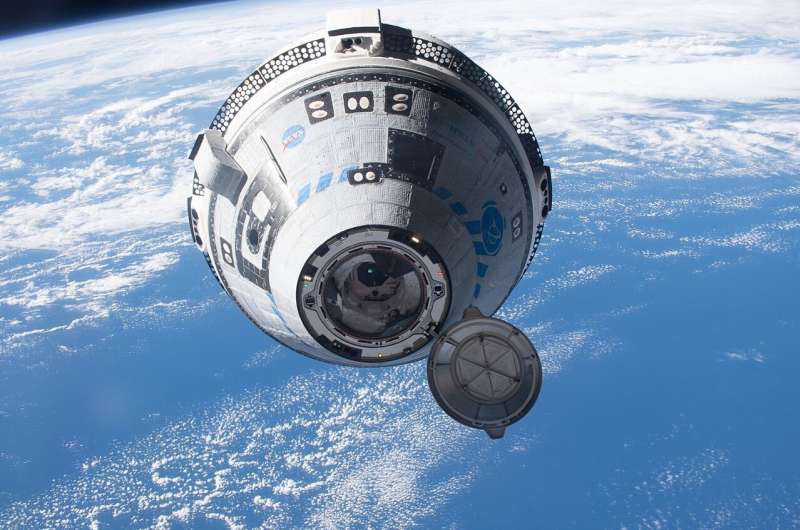August 10, 2024 report
This article has been reviewed according to Science X's editorial process and policies. Editors have highlighted the following attributes while ensuring the content's credibility:
fact-checked
trusted source
proofread
Saturday Citations: A rare misstep for Boeing; mouse jocks and calorie restriction; human brains in sync

This week's headlines include the extended sleepover for astronauts in the SpaceX Crew Dragon capsule, insight into our imitative behaviors, and the Olympic form of mice.
Starliner astronauts: 'We live here now'
Later this month, NASA will make a final decision about whether astronauts Butch Wilmore and Suni Williams will return to Earth aboard the mechanically troubled Boeing Starliner capsule or to continue using the Guest Bedroom Module on the International Space Station until February 2025, returning instead aboard a SpaceX Crew Dragon capsule. Wilmore and Williams launched into orbit for what was expected to be a weeklong visit to the ISS that was hampered by the capsule's mechanical problems, including helium leaks, that delayed docking.
Although NASA continues to assert its confidence in Boeing and the Starliner vehicle, planning is underway for a Crew Dragon launch on September 24 with a complement of two astronauts instead of the usual four, returning next February with Wilmore and Williams in what would be a pretty big humiliation for Boeing.
NASA and Boeing have been conducting tests with another Starliner vehicle to understand why the thrusters lost power during approach to the ISS and why several helium leaks occurred. "I think the NASA community in general would like to understand a little bit more of the root cause and the physics," said Steve Stich, program manager for NASA's Commercial Crew Program.
We are all individuals
Imitative behavior underlies social cohesion and cooperation, allowing people to engage with others to form teams, urban dance squads and violent mobs. Examples of mutually imitative behaviors include yawn contagion and mirroring facial expressions while conversing with a friend. The neural underpinnings of imitative behavior and brain plasticity are complex, and a new study led by researchers at the University of Bologna illuminates how the brain regulates these behaviors.
The researchers focused on the brain's motor system, using a noninvasive stimulation technique called cortico-cortical paired associative stimulation, which targets the plasticity mechanisms of the brain's connectome. Using this technique, they were able to enhance or hinder regions of the motor system to determine the roles of different pathways in facilitating or inhibiting imitative behaviors in test subjects.
They identified distinct social functions governed by different areas of the motor system, including the role of the ventral premotor area and the primary motor cortex in the enhancement of imitative behavior. The supplementary motor cortex has a cognitive control function, suppressing imitative behavior when the context calls for individual action. The example they cite is that of a football goalkeeper, who must suppress imitation of the forward's movement.
"Our findings open up new avenues for understanding how brain plasticity can be manipulated to increase or decrease imitative behavior and make people less sensitive to interference during task performance . This could lead to therapeutic applications to improve cognitive performance in patients with neurological impairments and social dysfunction disorders," says the study coordinator, Professor Alessio Avenanti.
Mice: Nature's jocks
Mice like exercise. A long time ago, researchers put a sensor-equipped running wheel near a colony of mice in a New York City park and were surprised to find that it was in more or less constant use 24 hours a day. A new study by UC Riverside scientists now finds that even calorie restriction does not inhibit their desire to exercise, challenging assumptions about the effects of dieting on exercise. The test mice included regular mice as well as "high runner" mice bred to seek exercise. They reduced the calorie load of the mice by 20% for three weeks, then by 40% in a subsequent week.
The high runners reduced total running distance slightly—by about 11%, though the researchers note that the amount of exercise in which the mice engaged was still quite high. The normal mice did not reduce the amount of exercise. Additionally, they exhibited little change in body mass.
"There has to be some type of compensation going on if your food goes down by 40% and your weight doesn't go down very much," says corresponding study author Theodore Garland Jr. "Maybe that's reducing other types of activities, or becoming metabolically more efficient, which we didn't yet measure."
© 2024 Science X Network




















